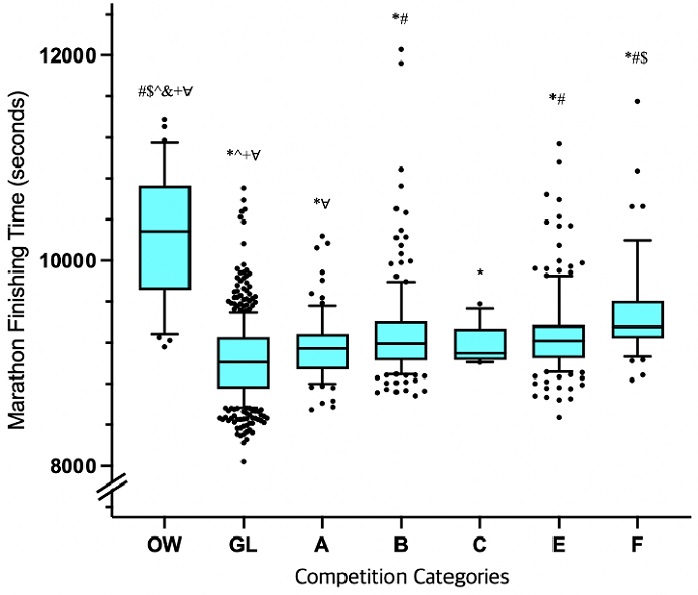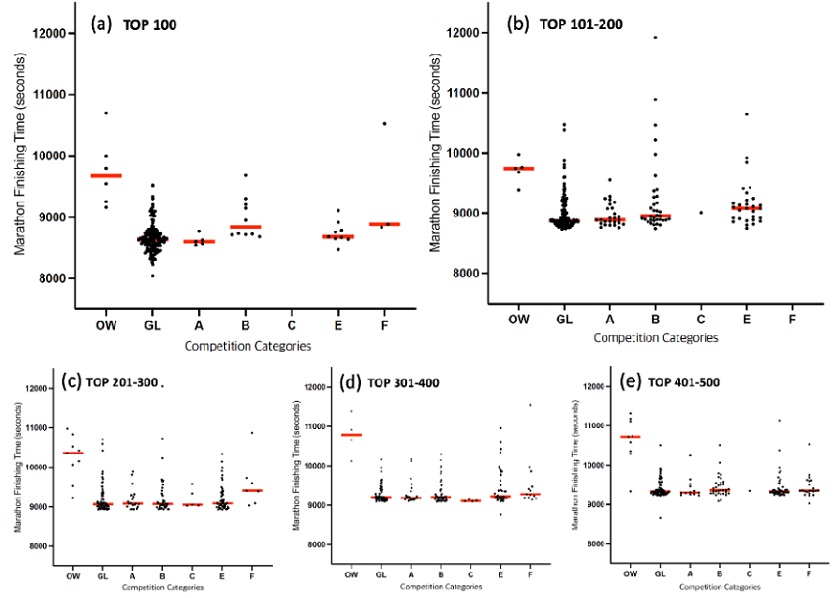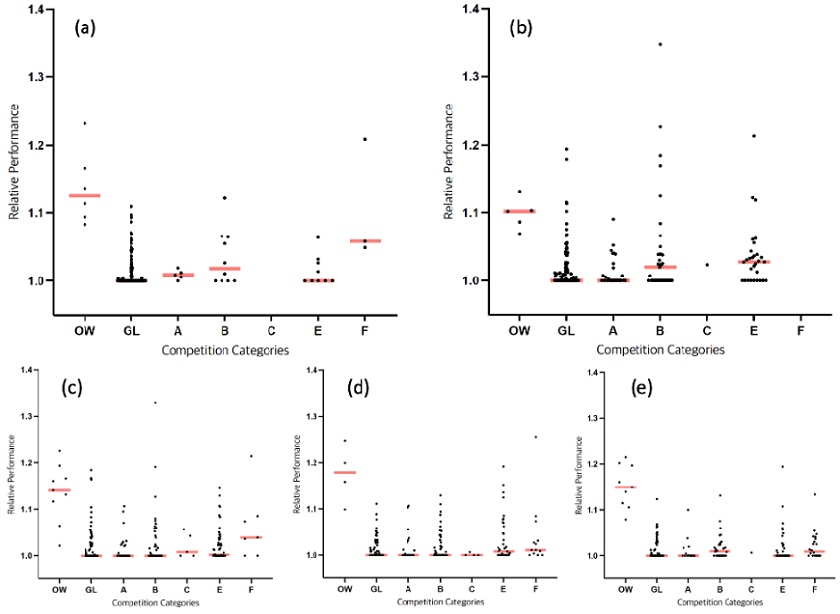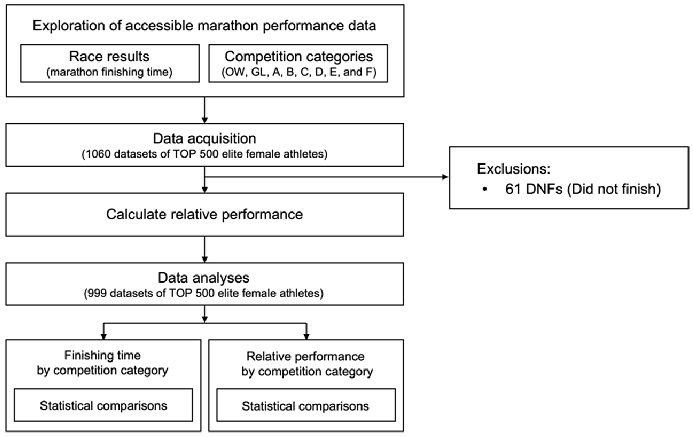1. Ballard SL, Wellborn-Kim JJ, Clauson KA. Effects of commercial energy drink consumption on athletic performance and body composition. Phys Sportsmed. 2015;38(1):107-117. DOI:
10.3810/psm.2010.04.1768.
2. Bangsbo J. (2015). Performance in sports - With specific emphasis on the effect of intensified training. Scand J Med Sci Sports., 25 (Suppl. 4), 88-99. DOI:
10.1111/sms.12605.
4. Deaner RO, Masters KS, Ogles BM, & LaCaille R. (2011). Marathon performance as a predictor of competitiveness and training in men and women. J Sport Behav., 34(4), 325-342.
5. Diaz JJ, Fernandez-Ozcorta EJ, & Santos-Concejero J. (2018). The influence of pacing strategy on marathon world records. Eur J Sport Sci., 18, 781-786. DOI:
10.1080/17461391.2018.1450899.
6. Diaz JJ, Fernandez-Ozcorta EJ, Torres M, & Santos-Concejero J. (2019). Men vs. women world marathon records' pacing strategies from 1998 to 2018. Eur J Sport Sci., 1-6. DOI:
10.1080/17461391.2019.1596165.
7. Hamstra-Wright KL, Coumbe-Lilley JE, Kim H, McFarland JA, & Huxel Bliven KC. (2013). The influence of training and mental skills preparation on injury incidence and performance in marathon runners. J Strength Cond Res., 27, 2828-2835. DOI:
10.1519/JSC.0b013e31828a4733.
8. Hoogkamer W, Snyder KL, & Arellano CJ. (2019). Reflecting on Eliud Kipchoge’s marathon world record: An update to our model of cooperative drafting and its potential for a sub-2-hour performance. Sports Med., 49, 167-170. DOI:
10.1007/s40279-019-01056-2.
9. Hopkins WG, Marshall SW, Batterham AM, & Hanin J. (2009). Progressive statistics for studies in sports medicine and exercise science. Med Sci Sports Exerc., 41(1), 3-12. DOI:
10.1249/MSS.0b013e31818cb278.
10. Hunter SK, Joyner MJ, & Jones AM. (2015). Last Word on Viewpoint: The two-hour marathon: What's the equivalent for women? J Appl Physiol., 118. DOI:
10.1152/japplphysiol.00144.2015.
12. Kim BJ, Kim SH, & Kim YG. (2013). Analysis of the marathon record of Korea and Japan. Korean J Sport., 11(4), 179-189.
13. Kim K, Ahn N, & Hong C. (2010). Paradigm of marathon coaching science. J Coach Develop., 12(2), 175-184.
14. Knechtle B, Di Gangi S, Rust CA, Villiger E, Rosemann T, & Nikolaidis PT. (2019). The role of weather conditions on running performance in the Boston Marathon from 1972 to 2018. PLoS One., 14, e0212797. DOI:
10.1371/journal.pone.0212797.
15. Knechtle B, Aschmann A, Onywera V, Nikolaidis PT, Rosemann T, & Rust CA. (2017). Performance and age of African and non-African runners in World Marathon Majors races 2000-2014. J Sports Sci., 35, 1012-1024. DOI:
10.1080/02640414.2016.1209302.
16. Konings MJ, & Hettinga FJ. (2018). The Impact of Different Competitive Environments on Pacing and Performance. Int J Sports Physiol Perform., 13(6), 701-708. DOI:
10.1123/ijspp.2017-0407.
17. Maffetone PB, Malcata R, Rivera I, Laursen PB. (2017). The Boston Marathon versus the World Marathon Majors. PLoS One., 12, e0184024. DOI:
10.1371/journal.pone.0184024.
18. Marc A, Sedeaud A, Guillaume M, Rizk M, Schipman J, & Antero-Jacquemin J. (2014). Marathon progress: demography, morphology and environment. J Sports Sci., 32, 524-532. DOI:
10.1080/02640414.2013.835436.
19. Moir HJ, Kemp R, Folkerts D, Spendiff O, Pavlidis C, & Opara E. (2019) Genes and elite marathon running performance: A systematic review. J Sports Sci Med., 18(3), 559-568.
20. Nikolaidis PT, Onywera VO, Knechtle B. Running performance, nationality, sex, and age in the 10-km, half-marathon, marathon, and the 100-km ultramarathon IAAF 1999-2015. J Strength Cond Res. 2017;31(8):2189-2207. DOI:
10.1519/JSC.0000000000001687.
21. Noble BJ, Maresh CM, Allison TG, & Drash A. (1979). Cardio-respiratory and perceptual recovery from a marathon run. Med Sci Sports., 11, 239-243. DOI:
10.1249/00005768-197901130-00003.
22. Onywera VO. (2009). East African runners: Their genetics, lifestyle and athletic prowess. Med Sport Sci., 54, 102-109. DOI:
10.1159/000235699.
23. Puthucheary Z, Skipworth JR, Rawal J, Loosemore M, Van Someren K, & Montgomery HE. (2011). Genetic influences in sport and physical performance. Sports Med., 41, 845-859. DOI:
10.2165/11593200-000000000-00000.
24. Renfree A, & St Clair Gibson A. (2013). Influence of different performance levels on pacing strategy during the Women's World Championship marathon race. Int J Sports Physiol Perform., 8, 279-285. DOI:
10.1123/ijspp.8.3.279.
25. Rodrigo CV, González MF, Santos DJ, Santos CJ, Maria GJ. Influence of advanced shoe technology on the top 100 annual performances in men’s marathon from 2015 to 2019. Sci Rep. 2021;11(22458):1-9. DOI:
10.1038/s41598-021-01807-0.
26. Sin ELL, Chow CN, & Cheung RTH. (2015). Relationship between personal psychological capitals, stress level, and performance in marathon runners. Hong Kong Physiother J., 33, 67-72. DOI:
10.1016/j.hkpj.2015.03.002.
27. Skiba PF, & JonesEli AM. (2011). Implications of the critical speed and slow component of VO2 for the 2-hour marathon. J Appl Physiol., 110, 280.
28. Wilber RL, & Pitsiladis YP. (2012). Kenyan and Ethiopian distance runners: what makes them so good? Int J Sports Physiol Perform., 7, 92-102. DOI:
10.1123/ijspp.7.2.92.
29. World Athletics. (2021). Available: http://www.iaaf.org/records/toplists/road-running/marathon/outdoor/women/senior. Accessed September 30.
30. World Athletics. (2021). http://www.worldathletics.org/athletes. Accessed September 30.
31. World Athletics. (2021). Available: : http://www.worldathletics.org/world-ranking-rules/road-running. Accessed September 30.
32. Zouhal H, Groussard C, Minter G, Vincent S, Cretual A, Gratas-Delamarche A, Delamarche P, & Noakes TD. (2011). Inverse relationship between percentage body weight change and finishing time in 643 forty-two-kilometre marathon runners. Br J Sports Med., 45, 1101-1105. DOI:
10.1136/bjsm.2010.074641.








 PDF Links
PDF Links PubReader
PubReader ePub Link
ePub Link Full text via DOI
Full text via DOI Download Citation
Download Citation Print
Print





